
The Illinois Terminal Railroad Company, known as the Illinois Traction System until 1937, was a heavy duty interurban electric railroad with extensive passenger and freight business in central and southern Illinois from 1896 to 1956. When Depression era Illinois Traction was in financial distress and had to reorganize, the Illinois Terminal name was adopted to reflect the line's primary money making role as a freight interchange link to major steam railroads at its terminal ends, Peoria, Danville, and St. Louis. Interurban passenger service slowly was reduced, ending in 1956. Freight operation continued but was hobbled by tight street running in some towns requiring very sharp radius turns. In 1956, ITC was absorbed by a consortium of connecting railroads.

Jubilee College State Park is an Illinois state park located 6 mi (9.7 km) west of Peoria, Illinois. It contains Jubilee College State Historic Site, a frontier Illinois college active from 1840 to 1862.
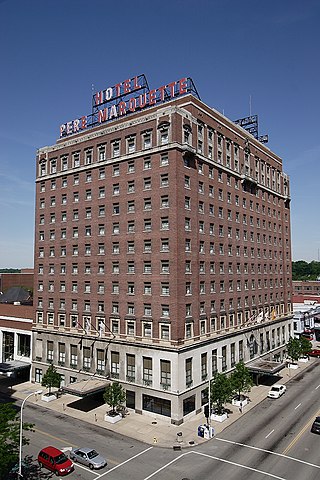
The Peoria Marriott Pere Marquette, is a historic 14-story hotel in downtown Peoria, Illinois, United States. Built in 1926, the building is Peoria's only surviving example of an upscale 1920s hotel. It was listed on the National Register of Historic Places in 1982.

Peoria City Hall, located in the United States city of Peoria, Illinois, is a historic red sandstone building designed by Reeves and Baillee. The city hall was built in 1897 and dedicated in January 1899. The building is still Peoria's city hall.
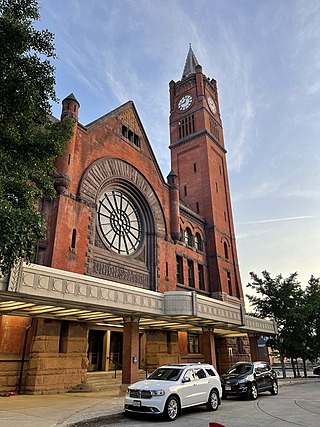
The Indianapolis Union Station is an intercity train station in the Wholesale District of Indianapolis, Indiana. The terminal is served by Amtrak's Cardinal line, passing through Indianapolis three times weekly.

Peoria State Hospital Historic District, also known as Bartonville State Hospital or Illinois Asylum for the Incurable Insane, was a psychiatric hospital operated by the State of Illinois from 1902 to 1973. The hospital is located in Bartonville, Illinois, near the city of Peoria in Peoria County. The hospital grounds and its 63 buildings are listed as a historic district on the National Register of Historic Places.

Peoria Mineral Springs is 14,500-year-old natural spring in the city of Peoria, Illinois, United States. The site, also known as Spring Hill, is located on a hillside on the historic West Bluff between Martin Luther King Jr. Drive and Moss Avenue.

Peoria Cordage Company was a major manufacturer of twine and cords, It operated in Peoria, Illinois for almost a century.

The Rock Island Depot and Freight House is a two-story railroad station and adjacent one-story freight house from the turn of the 20th century. It was constructed in 1899 directly besides the Illinois River in the American city of Peoria, Illinois. The depot and freight house are one of Peoria's last remaining historic reminders of the importance of passenger trains in the city's past, the other being the newer (1967) Rock Island station at 121 Morton Street now owned by the City of Peoria. The depot was built by the Chicago, Rock Island and Pacific Railroad as the terminus of a major branch line that delivered significant goods and passengers to Peoria. The 1900 opening of the depot was attended by "throngs of populous;" at its height before the depression of the 1880s, Peoria was a transportation hub. The station's clock tower was removed in 1939. The buildings were listed on the U.S. National Register of Historic Places in 1978. The last Rock Island train out of the station was the Peoria Rocket in 1978, of the company's Rock Island Rockets series.
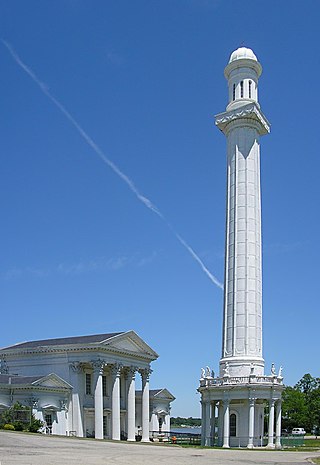
The Louisville Water Tower, located east of downtown Louisville, Kentucky near the riverfront, is the oldest ornamental water tower in the world, having been built before the more famous Chicago Water Tower. Both the actual water tower and its pumping station are a designated National Historic Landmark for their architecture. As with the Fairmount Water Works of Philadelphia, the industrial nature of its pumping station was disguised in the form of a Roman temple complex.

The Chicago Avenue Pumping Station is a historic district contributing property in the Old Chicago Water Tower District landmark district. It is located on Michigan Avenue along the Magnificent Mile shopping district in the Near North Side community area of Chicago, Illinois. It is on the east side of Michigan Avenue opposite the Chicago Water Tower.

Ambler's Texaco Gas Station, also known as Becker's Marathon Gas Station, is a historic filling station located at the intersection of Old U.S. Route 66 and Illinois Route 17 in the village of Dwight, Illinois, United States. The station has been identified as the longest operating gas station along Route 66; it dispensed fuel for 66 continuous years until 1999. The station is a good example of a domestic style gas station and derives its most common names from ownership stints by two different men. North of the station is an extant outbuilding that once operated as a commercial icehouse. Ambler's was the subject of major restoration work from 2005–2007, and reopened as a Route 66 visitor's center in May 2007. It was added to the U.S. National Register of Historic Places in 2001.

Fall River Waterworks is a 22-acre (8.9 ha) historic site located at the eastern end Bedford Street in Fall River, Massachusetts, along the shore of North Watuppa Pond. The property, which is still used as a water works for the city, contains the original pumping station, intake house and 121-foot (37 m) tall standpipe water tower. The system was originally built between 1872 and 1875, and expanded or upgraded many times. It was added to the National Register of Historic Places in 1981.

The Falmouth Pumping Station is a historic water pumping station on Pumping Station Road in Falmouth, Massachusetts. The complex consists of an 1898 Queen Anne pumping station designed by Ernest N. Boyden, a low-lift pump and water treatment building built in 1993, a chlorination tank also built in 1993, and a house and garage added in 1932. The plant was built in response to rising demand for vacation properties and fire suppression, and continues to fulfill those functions today. The complex was listed on the National Register of Historic Places in 1998.

This is a list of the National Register of Historic Places listings in Peoria County, Illinois.
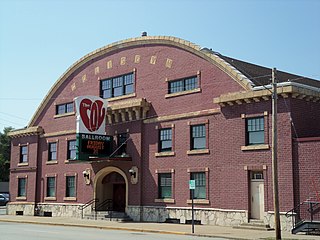
The Col Ballroom is a historic building located in the West End of Davenport, Iowa, United States. It was listed on the National Register of Historic Places and on the Davenport Register of Historic Properties as the Saengerfest Halle.

The Davenport Water Co. Pumping Station No. 2, also known as the Ripley Street Pumping Station No. 2, is a historic building located in central Davenport, Iowa, United States. It was listed on the National Register of Historic Places in 1984. The facility was originally built in 1884 to address problems with the city's water system, and had a reservoir that could hold 5 million US gallons of water. The building was subsequently replaced in 1986 by a smaller plain structure on the same property facing West 14th Street. Despite being replaced, the station remains an important part of Davenport's history, as it was an essential component of the city's water system and contributed to the growth of its residential areas above the bluff line from 1880 to 1920.

Grand Mound Town Hall and Waterworks Historic District, also known as Hose house, pump house, is a historic district located in Grand Mound, Iowa, United States. It was listed on the National Register of Historic Places in 2001. The district is composed of two buildings and the town's water tower.

The St. Louis, Peoria and Northern Railroad Depot, previously known as the Pekin Depot or Chicago and Alton Depot, is a historic railroad station in Pekin, Illinois. The station is one of the only historic rail-related buildings remaining in Pekin.
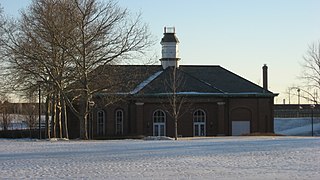
West Washington Street Pumping Station is a historic pumping station located at Indianapolis, Indiana. It was built in 1870, and is a one-story, rectangular brick building. It was modified to its present form after 1909, and is 2/3 of its original size. It has a slate hipped roof topped by a square central tower and features distinctive brick detailing, and arched openings. The building served as the city's only water pumping station until 1890.





















